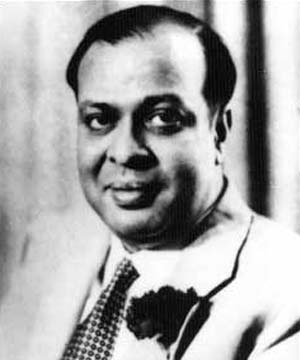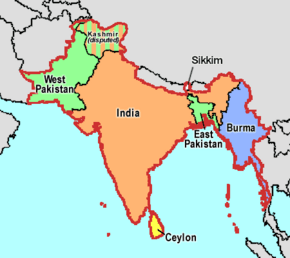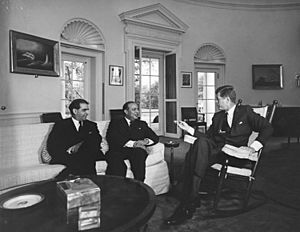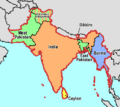Mohammad Ali Bogra facts for kids
Quick facts for kids
Mohammad Ali Bogra
মোহাম্মদ আলী বগুড়া محمد علی بوگڑا |
|
|---|---|
 |
|
| 3rd Prime Minister of Pakistan | |
| In office 17 April 1953 – 12 August 1955 |
|
| Monarch | Queen Elizabeth II |
| Governor General | Malik Ghulam Muhammad Iskandar Mirza |
| Preceded by | Khawaja Nazimuddin |
| Succeeded by | Muhammad Ali |
| 3rd & 7th Minister of Foreign Affairs | |
| In office 13 June 1962 – 23 January 1963 |
|
| President | Ayub Khan |
| Deputy | S.K. Dehlavi (Foreign Secretary) |
| Preceded by | Manzur Qadir |
| Succeeded by | Zulfikar Ali Bhutto |
| In office 24 October 1954 – 12 August 1955 |
|
| Deputy | J.A. Rahim (Foreign Secretary) |
| Preceded by | M. Zafarullah Khan |
| Succeeded by | Hamidul Huq Choudhury |
| Minister of Defence | |
| In office 17 April 1953 – 24 October 1954 |
|
| Deputy | Akhter Husain (Defence Secretary) |
| Preceded by | Khawaja Nazimuddin |
| Succeeded by | General Ayub Khan |
| Pakistan Ambassador to the United States | |
| In office November 1955 – March 1959 |
|
| President | Iskander Mirza |
| Preceded by | Syed Amjad Ali |
| Succeeded by | Aziz Ahmed |
| In office 27 February 1952 – 16 April 1953 |
|
| Governor General | Malik Ghulam |
| Preceded by | A. H. Isphani |
| Succeeded by | Amjad Ali |
| High Commissioner of Pakistan to Canada | |
| In office 1949–1952 |
|
| Governor General | Khawaja Nazimuddin |
| Pakistan Ambassador to Burma | |
| In office 1948–1949 |
|
| Governor General | Muhammad Ali Jinnah (1948) Khawaja Nazimuddin (1948–1949) |
| President of Pakistan Muslim League | |
| In office 17 April 1953 – 12 August 1955 |
|
| Preceded by | Khawaja Nazimuddin |
| Succeeded by | Muhammad Ali |
| Personal details | |
| Born |
Shahebzada Mohammad Ali Bogra
19 October 1909 Barisal, Bengal Presidency, British India |
| Died | 23 January 1963 (aged 53) Dacca, Pakistan (now in Bangladesh) |
| Resting place | Bogra Nawab Palace |
| Citizenship | (1909–1947) |
| Political party | Pakistan Muslim League |
| Spouses | Hameeda Begum Aliya Begum |
| Alma mater | University of Calcutta (B.A. in Polysci) |
| Cabinet | Ayub administration |
| Website | Official website: http://pmo.gov.pk/former_pms.php |
Mohammad Ali Bogra (born October 19, 1909 – died January 23, 1963) was an important politician and diplomat from Bengal. He served as the third Prime Minister of Pakistan from 1953 to 1955. He was also known as Mohammad Ali of Bogra.
After studying at the University of Calcutta, he began his political journey with the All-India Muslim League. In the 1940s, he joined the government in Bengal. After Pakistan became independent in 1947, he became a diplomat. He worked as Pakistan's ambassador to countries like Myanmar (1948), Canada (1949–52), and the United States (twice).
In 1953, he was called back from the United States to become Prime Minister. He took over from Khawaja Nazimuddin. As Prime Minister, he worked to make Pakistan's relationship with the United States stronger. He also tried to improve ties with China. He proposed a plan called the "Bogra Formula" to help create Pakistan's constitution in 1956. This plan made Pakistan a federal parliamentary republic.
Even though he was popular, he lost support from the Governor-General, Iskander Mirza. He was then re-appointed as Pakistan's Ambassador to the United States, serving until 1959. In 1962, he became the Foreign Minister of Pakistan under President Ayub Khan. He held this role until he passed away in 1963.
Contents
Early Life and Education
Family Background
Mohammad Ali Bogra was born on October 19, 1909, in Barisal, which was then part of British India. His family was wealthy and well-known, called the Nawabs of Bogra. The title Sahibzada (meaning "Prince") was used before his name to show his royal Bengali background.
His father, Nawabzada Altaf Ali Chowdhury, was a local politician. He was the Vice-President of the Muslim League in East Bengal. Mohammad Ali Bogra's grandfather, Syed Nawab Ali Chowdhury, was also a politician. He was the first Bengali Muslim minister and helped start the University of Dhaka.
School and College Years
Mohammad Ali Bogra grew up in Bogra. He first studied at Hastings House and then at a local Islamic school (madrassa) in Kolkata. After finishing school, he went to Presidency College at the University of Calcutta. He earned a Bachelor of Arts degree in political science in 1930.
He was married twice. His first wife was Begum Hamida Mohammad Ali, and they had two sons. Later, in 1955, he married Aliya Saddy. This second marriage caused some public discussion about polygamy in Pakistan.
Political Beginnings (1930–1947)
Joining the Muslim League
The Bogra family was already active in Bengali politics. Mohammad Ali Bogra joined the All-India Muslim League in 1930. In 1937, he ran in the general elections from Bogra and won. He became a member of the Bengal Legislative Assembly.
From 1938 to 1942, he served as the chairman of Bogra District. In 1943, he became a parliamentary secretary to the Chief Minister, Khawaja Nazimuddin. In 1946, Huseyn Shaheed Suhrawardy asked him to join his government. Mohammad Ali Bogra then held important roles as minister for health, finance, and local government. As health minister, he helped establish the Dhaka Medical College.
Supporting Pakistan's Creation
Mohammad Ali Bogra supported the Muslim League's idea for creating Pakistan. He won his election in 1945 and joined the first Constituent Assembly of Pakistan in 1947. In 1948, he met Governor-General Muhammad Ali Jinnah in Dhaka. He disagreed with Jinnah about not making Bengali an official language of Pakistan.
Diplomatic Career (1947–1952)
Serving as Ambassador
In 1948, Prime Minister Liaquat Ali Khan asked Bogra to be Pakistan's ambassador to Egypt. Bogra chose to be ambassador to Myanmar instead. He started his work in Yangon in 1948. In Myanmar, he showed a strong anti-communist view. He supported Myanmar's military actions against communism. He was concerned about communism spreading to Pakistan.
In 1949, he became Pakistan's High Commissioner to Canada, serving until 1952. In 1952, he was appointed Ambassador to the United States.
Building Ties with the United States
Mohammad Ali Bogra played a key role in making Pakistan more dependent on the United States. He worked to get military and economic help for Pakistan. He presented Pakistan as a "front-line state" against the spread of communism from the Soviet Union. He convinced American leaders, including President Dwight D. Eisenhower, that Pakistan was against communism.
He also suggested that Pakistan's military was the only one in the region ready to fight Soviet expansion. In 1952, he signed an agreement with the U.S. government for American military advisors to be sent to Pakistan. Some people in Pakistan saw him as very pro-American. Historians believe his strong anti-communist views damaged Pakistan's relationship with the Soviet Union in the 1950s.
Prime Minister of Pakistan (1953–1955)
Becoming Prime Minister
In 1953, there were protests about the language movement in East Pakistan. There were also riots in Lahore. These events led to Prime Minister Khawaja Nazimuddin being dismissed by Governor-General Malik Ghulam Muhammad.
Mohammad Ali Bogra was called back from Washington D.C. Governor-General Ghulam Muhammad appointed him as the new Prime Minister and the head of the Pakistan Muslim League. Bogra was more of a diplomat than a politician, and not many people knew him. He accepted the role and initially kept the foreign affairs and defense ministries for himself.
New Cabinet and Foreign Policy
Prime Minister Bogra formed a new cabinet called the "Ministry of Talents." This cabinet included General Ayub Khan as the Defense Minister and Iskander Mirza as the Interior Minister.
His appointment was well-received in the United States. U.S. Secretary of State, John Foster Dulles, called Pakistan a "bulwark of Freedom in Asia." U.S. President Dwight D. Eisenhower ordered immediate shipments of wheat to Pakistan. Bogra wanted to strengthen military ties with the U.S. He signed many treaties that brought the two countries closer.
His foreign policy was strongly against the Soviet Union, which he saw as "imperialist." However, he did not label China the same way, even though both were communist. In 1955, he led Pakistan to the Bandung Conference in Indonesia. This was the first time China and Pakistan had high-level contact.
Some experts believe Bogra's strong focus on the United States and his anti-communist views hurt Pakistan's relationship with the Soviet Union. They also think it made Pakistan's foreign policy too influenced by the U.S.
Relations with India
Under pressure from the United States, Bogra started to improve ties with India. He first tried to address the Kashmir conflict. In 1953, he met with Indian Prime Minister Jawaharlal Nehru in London. He welcomed Nehru when he visited Karachi, and Bogra visited New Delhi soon after.
Mohammad Ali Bogra had a good relationship with Nehru. They both agreed on a public vote (plebiscite) in Kashmir. However, this plan did not happen because Bogra lost support from some groups in Pakistan. Bogra believed that a stronger military would help achieve peace in the region. He said, "When there is more equality of military strength, then I am sure that there will be a greater chance of settlement."
The Bogra Formula
The Bogra Formula was a political plan proposed by Prime Minister Bogra on October 7, 1953. He wanted to create a written constitution for Pakistan. Within six months, he announced his proposal for the constitution.
His plan suggested a stronger two-house parliament with a National Assembly and a Senate. Both houses would have equal representation from the five provinces: Punjab, Khyber Pakhtunkhwa, Balochistan, Sindh, and Bengal. The National Assembly would have 300 seats based on population, and the Senate would have 50 seats, with equal representation for each province.
Bengal would have more seats in the National Assembly due to its larger population. However, the combined seats from the other four provinces would balance Bengal's power in the parliament. Both houses would have equal power. If there was a disagreement, the issue would be discussed in a joint meeting.
The Bogra Formula also aimed to replace the British monarchy's representative, the Governor-General, with an elected President. It also included a system of checks and balances. If the President was from the four western provinces, the Prime Minister would be from East Bengal, and vice versa. The President would be elected for a 5-year term by both the National Assembly and the Senate.
The plan also gave more power to the Supreme Court of Pakistan. It would decide if laws followed the teachings of the Quran. The Bogra Formula was very popular because people saw it as a way to unite the two parts of Pakistan.

However, Governor-General Malik Ghulam Muhammad felt his powers would be reduced. With the support of the military, he dissolved the Constituent Assembly in 1954. This stopped the Bogra Formula from being fully implemented.
The One Unit Plan
After the Bogra Formula failed, Mohammad Ali Bogra started working on the "One Unit" program. This plan aimed to combine the four western provinces into a single province called West Pakistan. He believed this would strengthen Pakistan's unity. He said, "There will be no Bengalis, no Punjabis, no Sindhis, no Pathans, no Balochis... The disappearance of these groups will strengthen the integrity of Pakistan."
In 1954, he led the creation of the One Unit program with the support of Governor-General Ghulam Muhammad.
Dismissal and Return to Diplomacy (1955–1959)
On August 4, 1955, Governor-General Malik Ghulam Muhammad took a leave of absence due to illness. Iskander Mirza, who was the Interior Minister, became the Acting Governor-General.
Soon after, Mirza and Prime Minister Bogra had disagreements. Mirza forced Bogra to resign, ending his time as Prime Minister. Governor-General Mirza then appointed Bogra as Pakistan's Ambassador to the United States again. He served in this role until 1959.
Later Years and Foreign Minister Role (1962–1963)

In 1959, Mohammad Ali Bogra left his ambassadorial role. In 1962, he joined President Ayub Khan's government as the Foreign Minister of Pakistan. He took over from Manzur Qadir.
As Foreign Minister, he visited China and began talks that led to a peaceful agreement on Pakistan's northern borders. He continued a pro-Western policy but also tried to improve relations with the Soviet Union. This was especially after the Western countries and the United States supported India during the Sino-Indian War in 1962. After visiting the Soviet Union with President Ayub, Bogra said, "There was no such thing as friends forever or enemies forever– only national interests count."
Mohammad Ali Bogra's health became a serious issue during this time. He passed away in Dhaka in 1963 and was buried in Bogra Nawab Palace in Bangladesh.
Images for kids
-
In 1955, the One Unit Scheme integrated the four provinces of the western wing of Pakistan into a single province, West Pakistan.
-
Mohammad Ali Bogra (center) with John F. Kennedy (right) at the Oval Office in 1962
See also
 In Spanish: Mohammed Alí Bogra para niños
In Spanish: Mohammed Alí Bogra para niños



